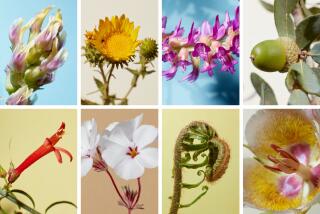In Cornwall, an eco-vision of Eden
Near St. Austell, England
It was a barrage on the senses. The hot sun drew beads of sweat on my face. I heard the rush of a nearby waterfall and yearned to feel its cool mist. My eyes feasted on the purple Cryptostegia grandiflora blooming beside a path and other exotic foliage layered like strokes of a paintbrush. In the distance, jungle drums rose to a crescendo.
As my family made its way through this foreign forest, I had to remind myself where we were: the Cornwall district of England.
Here, 270 miles west of London, a park called the Eden Project is to plants and ecology what Disneyland is to fun and fantasy. Since opening in March 2001, two translucent eco-igloos called “biomes” have stood as the world’s largest conservatories, according to their builders. Less prominent but equally charming are abundant environmental artworks, including my favorites: copper figures writhing in a Dionysian dance inside a simulated Mediterranean vineyard.
The park is billed as “the living theater of plants and people.” If you view the biomes and outdoor gardens as a dramatization about the interdependence of humans and their habitat, the stage — a part of the Cornish countryside devastated by mining — begins to make sense.
The $137-million project operates under the auspices of the Eden Trust, whose mission is to generate awareness of the environment and inspire visitors to protect it. My husband, Warren Lancaster, and our 9-year-old twin boys, Cameron and Lachlan, found the place as entertaining as it was educational. That none of us was of a botanical bent seemed irrelevant, as was the fact that the Eden Project wasn’t even on our original itinerary.
Bond — James Bond
We had been touring Devon for three days earlier this month. Our hosts were my former college roommate Anne Jackson, an artist, and her husband, Nick Smirnoff, a plant physiologist at the University of Exeter, so I suppose a visit to the Eden Project always was in the cards. All my boys had to hear was that scenes from the recent James Bond movie “Die Another Day” had been filmed there, and soon we were crossing into Cornwall with Anne as our guide.This Eden was designed to be discreet. Even though the surrounding terrain — ravaged by mining and left barren — could have used a distraction, we didn’t glimpse the park until we were practically on top of it.
The project covers 35 acres of a former clay-mining pit, and it’s dominated by the Humid Tropics Biome. About 785 feet long, 360 feet wide and 165 feet tall, it’s big enough to house the Tower of London and more than twice the size of the Warm Temperate Biome.
From the top of the Zigzag, the path that leads through the grounds, the bubble-shaped biomes looked like a set from a 1950s sci-fi movie. I expected giant antennae to rise from behind the honeycomb of hexagonal panels, each made of inflated layers of plastic film. I laughed when I later saw “The Bee,” a towering sculpture by Cornwall artist Robert Bradford that salutes the importance of pollination.
The long queue closer to the biomes turned out to be visitors lined up for a Cornish pasties stand. Unwilling to wait, we went to the cafeteria for sandwiches and salads — all organic and eaten with wood utensils.
Anne told us that the Humid Tropics Biome was the most dramatic, and Lachlan lunged in its direction.
But with food still on the brain, I insisted we make the Warm Temperate Biome our appetizer before the main course.
“Ahhh,” Anne sighed as she crossed into the simulated temperate climate of the Mediterranean, Southwest Australia, the tip of South Africa and parts of California. “I’d like to live here.”
I agreed, enticed by the dry air perfumed with thyme, lavender and ginger lilies.
Signs and exhibits were reminders that we were here to learn. Unlike the ill-fated Biosphere 2 project in Arizona, Eden was envisioned from the start as more an educational showcase than a scientific experiment. No crew lives sealed inside, separated from the outside world.
The point here is to invite inside and educate as many people as possible. We learned, for example, that an olive grove supports more animal species than a pine forest. Walking through a reproduction of South Africa’s fynbos (fine-leafed bush scrublands), we read that 5,000 of that habitat’s 7,000-plus plant species are found nowhere else and that these species are threatened by pollution and human encroachment.
Both biomes emphasized that we are dependent on plants not just for comfort but for survival, above and beyond the breath of life they provide from oxygen. It was a profound statement delivered in a gentle, palatable way. I couldn’t imagine a more clever classroom — or art gallery.
The copper sculpture of Dionysus as a bull surrounded by his maenads is by Cornwall artist Tim Shaw. We also loved Heather Jansch’s sow and piglets fashioned from cork oak. Turns out the tree’s acorns feed Iberian pigs that become gourmet ham.
It’s the humidity
We left the Warm Temperate Biome for the Humid Tropics Biome, where the air wrapped us like a light but tight coat. The path first simulated tropical South America and later introduced us to plants in other rainforest regions, such as West Africa and Malaysia.We saw a huge travelers palm, which collects rainwater in the hollows of its leaves.
Also on display in the re-created Oceanic Islands region was a fledgling coco de mer, or sea coconut palm, native to the Seychelles islands off Africa’s eastern coast. The tree boasts the largest seed in the world. The one here is displayed in a lighted box with slits, creating a peep-show effect surely inspired by the seed’s callipygian contours.
We peered into the softly lighted interior of a traditional Malaysian house, made of rattan, bamboo and recycled timber, including old telephone poles. The dwelling was spartan, but with surroundings so serene, I could see why some people would fantasize about living there.
I, however, was sweating after about 10 minutes. While apricot tree leaves flutter in the artificial breeze of the Warm Temperate Biome, here in the sticky tropics, captured rainwater is sent through fogging nozzles to make mist as the dome above lets sunlight — UV rays and all — pass through.
Fortunately, spots of shade are interspersed through the routes, and exits are offered to those who can’t stand the heat.
Meanwhile, the hearty are rewarded with exotic flora such as the spiky Cyperus papyrus, whose long stalks end in a billowy profusion of thread-like leaves, reminiscent of the light trail left by bursting fireworks.
At a junction in the path, I chose the high road and considered how Eden visitors could reach their daily exercise quota here. (People who walk the entire project log about 1 1/2 miles.) My reward for climbing toward the top of a 130-foot cascade of water was a fine view of the realm.
Two “vegetalistas,” shaman herbalists from Peru named Francisco Montes Shuna and Yolanda Panduro Baneo, had painted pictures of the spirit lives of rainforest plants. Other art was more tongue-in-cheek. Near where the high road merged with the low road we found a crumpled West African kola tree, the source of caffeine-rich kola nuts. Under this tree, though, old soda cans played the part of fallen fruit.
Elsewhere, overflowing horns of plenty reminded us that we have the rain forests to thank for rubber gloves, chocolate, dyes, even lip gloss.
My family and friend were, like me, somewhat dazed from the journey into this lost world. Flushed of face, all of us tumbled into the air-conditioned link between the biomes and made a beeline to an ice cream stand.
I found myself pondering the world my children would inherit if we humans didn’t cherish and protect the Earth’s vegetation. As much as we had enjoyed visiting these biomes, I didn’t want my children ever reduced to living in one.
*
(BEGIN TEXT OF INFOBOX)
Fly east to Eden Project
GETTING THERE:
Most travelers visit the Eden Project as a day trip. From LAX, nonstop service to London is available on Air New Zealand, American, British, United and Virgin Atlantic. Direct flights (at least one stop but no change of planes) are offered on Continental. Restricted round-trip fares begin at $838.
Trains run between London and St. Austell, about 265 miles. Buses make the four-mile trip from St. Austell to the Eden Project. An admission ticket that includes train fare and bus transfer is available by calling National Rail, 011-44-8457-484-950, https://www.nationalrail.co.uk . (Click on “Special Offers,” then “Wessex Trains.”)
WHEN TO GO:
The Eden Project is open daily except Dec. 24 and 25. Hours are 9:30 a.m.-6 p.m. through Nov. 2. (Reduced hours in winter.) The project will stay open until 9 p.m. Tuesday-Thursday starting this week through Aug. 28.
ADMISSION:
Ages 16-59, $16; seniors 60 and older, $12; students, $8; children 5-15, $6.50; children younger than 5, free. A family pass good for two adults and three children is about $40.
WHERE TO EAT:
Two restaurants are on the premises. Zzub Zzub is a cafeteria with lower prices. I had delicious soup with mushrooms and fresh chives; a tuna-and-pasta salad with cole slaw costs about $6. Morocco Red has a more elaborate menu and table service; expect to pay a few dollars more.
TO LEARN MORE:
Eden Project, Bodelva, St. Austell, Cornwall PL24 2SG, England; 011-44-1726-811-911, fax 011-44-1726-811-912, https://www.edenproject.com .
St. Austell Tourist Information Centre, Southbourne Road, St. Austell, Cornwall PL25 4RS; 011-44-1726-879-500, fax 011-44-1726-874-168, https://www.cornishriviera.co.uk .
Visit Britain, 551 Fifth Ave., Suite 701, New York, NY 10176; (800) 462-2748, https://www.travelbritain.org .
— Debbie Seaman
More to Read
Sign up for The Wild
We’ll help you find the best places to hike, bike and run, as well as the perfect silent spots for meditation and yoga.
You may occasionally receive promotional content from the Los Angeles Times.






